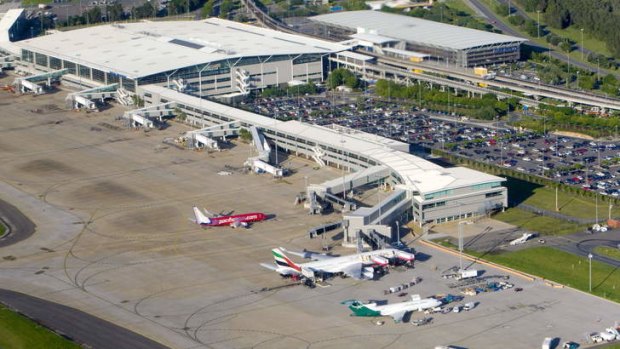This was published 11 years ago
Brisbane Airport up the runway without a paddle? Experts offer solutions

Brisbane Airport's international terminal.Credit: Glenn Hunt
Moving smaller “non-essential” aircraft to the Gold or Sunshine Coast airports, improving arrivals and departures technology and building a second runway have been raised as the options most likely reduce delays at Brisbane Airport.
The proposals outlined to Fairfax Media on Wednesday followed the release of figures showing the airport had the worst delays for incoming flights in the country, with only 69.2 per cent of arriving flights in December landing within 15 minutes of their scheduled time.
But a new runway – the most urgent, and expensive, remedy – will not be a reality for at least another seven years, according to the Brisbane Airport Corporation which is unsure who will pay for the $1.3 billion strip.
Though BAC had the capital to complete work on phase one of a new runway by the end of this financial year, spokeswoman Leonie Vandeven said there uncertainty about who would fund the work from stage two onwards.
Much of that uncertaintly stems from a standoff between the airport and airlines that exploded last year when Qantas chairman Alan Joyce publicly refused to pay in advance for the runway.
Ms Vandeven said BAC's conversations with Qantas and other airlines “were ongoing”, but she had “no idea” when there would be an outcome.
“Prefunding is a necessity,” she said. “We expect 75 per cent will be covered by shareholders, with just 25 per cent through passenger movement charges.
“My understanding is that [airlines pay for those charges] through the ticket price.”
But a Qantas spokesman said the airline's position remained unchanged.
“Qantas has made it clear that we will not be pre-funding the construction of the runway, particularly when our aircraft will not be using it for another eight years,” he said.
"We have never been asked to pre-fund a piece of infrastructure like this.
"We support measures to ease capacity constraints at the airport, including the construction of the new runway, however we don't think airline customers should pay for this until the runway is operational."
In the meantime, Ms Vandeven said BAC would implement “a suite of improvements” to ensure flight delays were mitigated, even against rising demand.
Those improvements would include a new runway management system which capped the amount of scheduled flights between peak times to 50 per hour and reopening a smaller runway, which had been closed for maintenance, in February.
However placing limitations on flights is a sign the airport is struggling, according to leading aeronautical expert and Head of Aviation at Central Queensland University, Ron Bishop.
Mr Bishop said airports grappling with infrastructure constraints amid significant growth had to “get creative” until they got the extra space.
“If you've got airlines having to pay more to use the airport, or facing restrictions around landing, those costs will likely be passed on to customers,” he said.
“Not forgetting the costs associated with delays - and when you consider how many craft are moving through the airport every day and that's only going to grow over the years - you see that's a lot of people and businesses [affected].”
According to BAC figures, Brisbane Airport saw about 210,000 aircraft movements in 2012, which puts it just behind London's Gatwick Airport (236,000) as the second-busiest single-runway airport in the world.
Such figures justifed the creation of a second runway at Brisbane Airport, argued Chief Executive Officer of Aviation Aerospace Australia Jim Carden.
BAC also needs to do something to reduce the number of “non -essential”, smaller aircraft which currently use the runway Mr Carden said, raising the option of moving them to the Archerfield, Gold and Sunshine Coast airports
“It's probably not a great thought,” Mr Carden said. “Though the fact is, if you're sitting on aircraft, waiting to leave, that little aircraft in front of you is taking up more room on the runway than your big commercial flight is.
"Everyone has to stop and wait for the turbulence and the wind and all the other conditions to be right.”
But Mr Bishop said so much was already occurring, and with the Gold and Sunshine Coast airports also seeing more international movement, there wasn't much more room to move.
“What is for certain is that things aren't going to get better any time soon,” he said.
Sign up for the Traveller newsletter
The latest travel news, tips and inspiration delivered to your inbox. Sign up now.